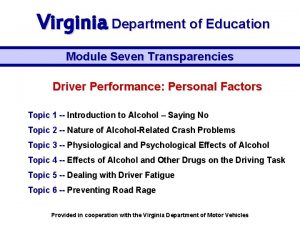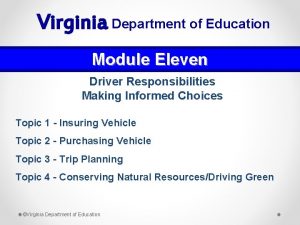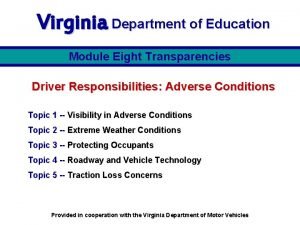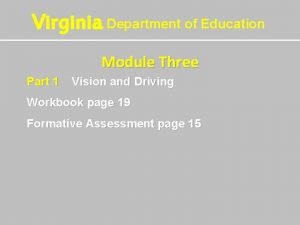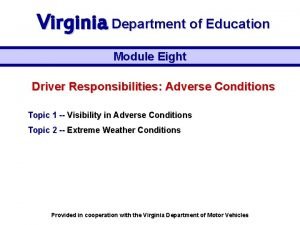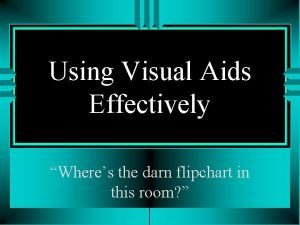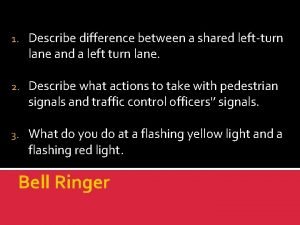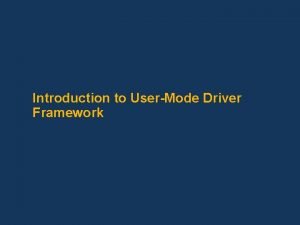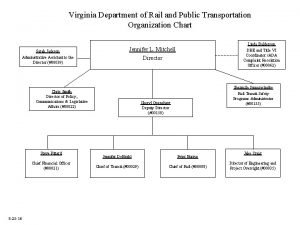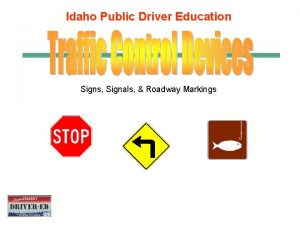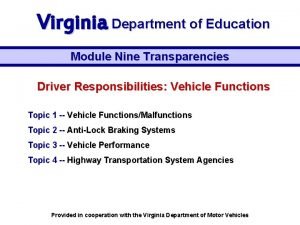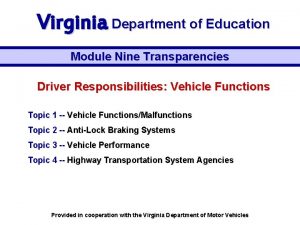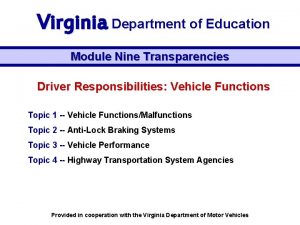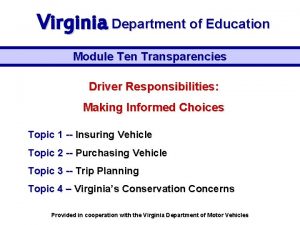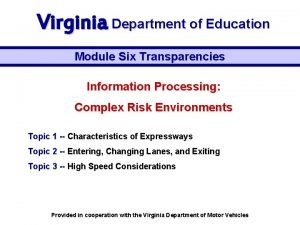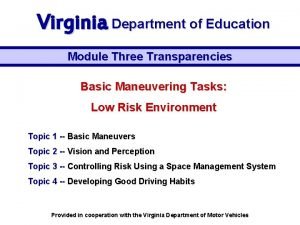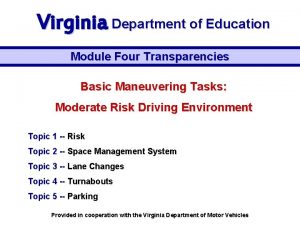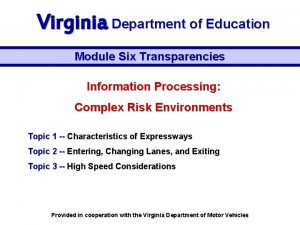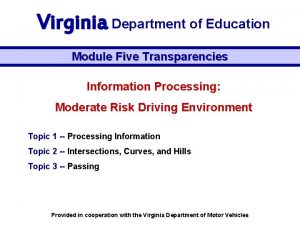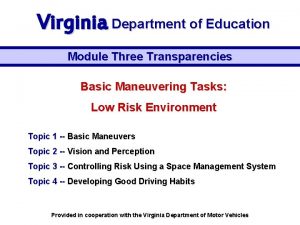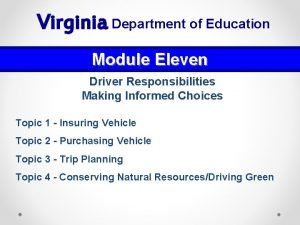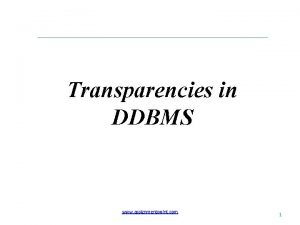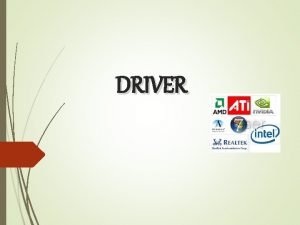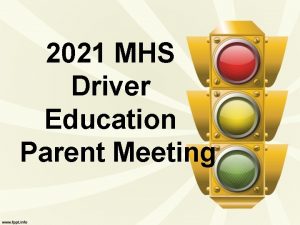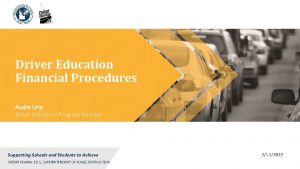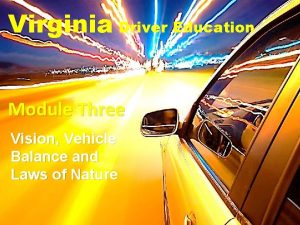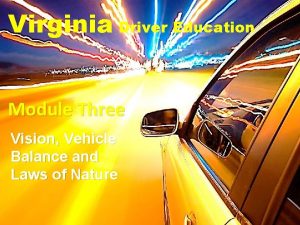Virginia Department of Education Module Eight Transparencies Driver
































- Slides: 32

Virginia Department of Education Module Eight Transparencies Driver Responsibilities: Adverse Conditions Topic 1 -- Visibility in Adverse Conditions Topic 2 -- Extreme Weather Conditions Topic 3 -- Protecting Occupants Topic 4 -- Roadway and Vehicle Technology Topic 5 -- Traction Loss Concerns Provided in cooperation with the Virginia Department of Motor Vehicles

Topic 1 Lesson 1 Changing Visibility at Night The ability to identify risks depends on vision, and visual acuity is severely limited at night. Driving at night: ü reduces the illumination of risks. ü requires the eyes to adjust quickly to glare. ü places limitations on gathering and processing information in time. When visibility is reduced at night a driver needs more time to: ü identify hazards early and scan in and around the path of travel to the target area, and ü scan the road beyond the lighted zone. (If you only scan the lighted zone you may miss important clues that warn you of hazards ahead. ) T – 8. 1

Topic 1 Lesson 1 Visibility Limitations at Night ü The distance you can see ahead is inadequate at higher speeds ü Your headlights provide limited illumination of off-road areas ü A loss of contrast impairs your ability to judge distances ü Blinded by glare from lights of oncoming and following vehicles ü Distance traveled during glare recovery time T – 8. 2

Topic 1 Lesson 2 Headlight Alignment and Speed The Code of Virginia requires that you use your headlights from sunset to sunrise and during inclement weather, such as rain, fog, snow, or when you use your windshield wipers. At twilight, when the sun light begins to fade, turn your headlights ON. This will make your vehicle more visible to others. Properly aligned LOW BEAM headlights Ø beam hits roadway 100 to 150 feet ahead Ø illuminates area above road 300 to 500 feet ahead Ø load, load distribution, and vehicle height affect light beam distance Ø a maximum safe speed of 40 to 45 mph is based on your ability to stop within the lighted area illuminated roadway 100 to 150 feet lighted area above road 300 to 500 feet T – 8. 3

Topic 1 Lesson 2 Headlight Alignment and Speed Properly Aligned High Beam Headlights ü the beam hits the roadway 300 to 500 feet ahead ü illuminates the area above the road 500 to 1800 feet ahead ü load, load distribution, and vehicle height affect light beam distance ü maximum safe speed is 65 mph based on your ability to stop within the lighted area illuminated roadway 300 to 500 feet lighted area above road 500 to 1800 feet Lower (dim) high-beams headlights when you are: ü within 500 feet of an approaching vehicle ü following closely behind another vehicle (within 200 feet) ü driving on lighted roadways ü driving in fog, heavy rain, sleet, snow, or dust T – 8. 4

Topic 1 Lesson 2 Headlight Alignment and Speed Overdriving your headlights ü Your vehicle’s stopping distance is greater than the distance lighted by your headlights. ü To determine if you are overdriving your headlights, select an object the moment the headlights pick it up, and count off six seconds. v If the object is still ahead of your vehicle, you are driving at a safe speed. v If you have passed it, you are driving too fast. 1000 and 1 1 second 1000 and 6 6 second Fixed Object 1000 and 6 6 second Speed is Safe Ø The posted speed limits are calculated for daylight driving and are often too fast for nighttime conditions. Ø Dirty headlights and improper headlight alignment will add to this traffic safety problem. Speed is too FAST T – 8. 4 a

Topic 1 Lesson 2 Nighttime Precautionary Measures Clean windshield inside and out. ü Windblown sand/dirt particles cause special problems. ü Diffused light gives the appearance of a halo around the headlights of the oncoming vehicle. Clean all lights. ü 50 to 90 percent loss of headlight efficiency is due to road grime. Reduce daytime speed. Increase following interval. Turn off interior lights. Look to the right of oncoming vehicles. Use high/low headlight beams properly. Use parking lights only when parked. If stopped beside road, take appropriate safety measures. Use day/night switch on rearview mirror. T – 8. 5

Topic 1 Lesson 2 Nighttime Precautionary Measures Headlights — passing or being passed Try to avoid blinding other drivers with your lights ü Before passing (approximately 600 feet), the driver passing can flash his/her headlights to warn the other driver. ü When two vehicles are side by side, the passing driver may switch to high beams, and the driver being passed to low beams. Pedestrian safety Don’t Wear Dark Clothes Wear Stripes Carry a Handkerchief Retroreflective Material Ø Be alert for pedestrians walking on unlighted roadways after dark. Ø If you must walk on a dark roadway due to vehicle breakdown or for any other reason, carry a white handkerchief or wear light-colored clothing. If possible, wear reflective vests or other reflective clothing if you must be on or near a road at night. Having reflective stripes increases your chances of being seen. In snow wear dark clothing to create a contrast. T – 8. 6

Topic 1 Lesson 3 Visibility Limitations in Fog Driving in Drifting Fog Reduce speed Make sure your headlights are on low beam (aimed at the road surface) to reduce the amount of light/glare reflected back at you Turn on your windshield wipers If necessary, turn on the defroster or air conditioner T – 8. 7

Topic 1 Lesson 3 Visibility Limitations in Fog Driving in Heavy Fog Ø Reduce speed, but NEVER stop in a travel lane Ø Turn on emergency flashers Ø Look for an exit from the highway If impossible to leave highway ü stop beyond end of guard rail ü back up to outboard of the guard rail ü turn off all lights ü wait for the fog to lift T – 8. 8

Topic 1 Lesson 3 Visibility Limitations in Bad Weather Stopping Distance ü Reduce speed to accommodate shortened sight distance ü Do not stop in travel lane or on shoulder ü Turn headlights to low beams ü Turn on emergency flashers when traveling below speed limit ü Maintain appropriate lane position ü If your stopping distance is longer than your sight distance, Visibility Range you have created a high risk situation – slow down Braking distances at 20 mph with conventional tires on different pavement conditions Ice - 150 feet Packed Snow - 60 feet Wet - 25 feet Dry - 20 feet T – 8. 9

Topic 1 Lesson 3 Precautions in Bad Weather Turn on windshield wipers Be alert for vehicles stopped on the roadway Be prepared for effects of gusting or strong steady crosswinds Make all steering, accelerating, and braking actions gently and smoothly T – 8. 10

Topic 1 Lesson 3 Precautions in Bad Weather In severe snow conditions, look for exit from highway and turn on the radio for a weather report If impossible to leave highway, stop beyond the outboard end of guard rail Use cell phone to check conditions Smoke, ice, fog, and snow often require use of windshield washer T – 8. 11

Topic 2 Lesson 1 Low Water Crossings Flash Flooding Conditions Not Specific to Time of Year Affects braking, steering and engine systems T – 8. 12

Topic 2 Lesson 1 Low Water Crossings Nearly 50% of flash flood fatalities are vehicle related Search for flood prone areas: - highway dips - bridges - low areas Most vehicles will float Very little water on the road surface can cause loss of control T – 8. 13

Topic 2 Lesson 1 Low Water Crossings § Two feet of water “carries” most cars § Because visibility is limited at night, driving during flooding condition is very dangerous § Heed all flash flood watches and warnings § Monitor road conditions through the news media T – 8. 14

Topic 2 Lesson 2 Hot and Cold Temperatures Additional Demands on Vehicle Systems Vehicles are designed to operate in a wide range of temperatures, from very hot to extremely cold. However, these extreme conditions can cause stress to any vehicle part that is temperature sensitive. In Extreme Weather… üCheck tires üCheck fluids üCheck belts T – 8. 15

Topic 2 Lesson 2 Cold Weather Precautions • Tires should be balanced, aligned, the proper type, and have adequate tread - The legal minimum, 2/32 of an inch tread depth, is inadequate on wet surfaces • Check tire inflation - Check cold tire pressure regularly (noted inside driver’s door or in manual) - The maximum tire pressure listed on the tire sidewalls is NOT the recommended tire pressure • Check radiator coolant, hoses, and connections T – 8. 16

Topic 2 Lesson 2 Cold Weather Checks ü Check heater, defroster and air conditioner system ü Winterized windshield wiper fluid ü Check drive belts for tension and wear ü Keep lights and glass areas clear and clean ü Check windshield wiper blades T – 8. 17

Topic 2 Lesson 2 Hot Weather Checks Tire inflation needs special attention Underinflated tires are subject to heat and pressure buildup due to excessive flexion, especially when driving for extended distances at higher speeds. The air conditioner, radiator coolant hoses, connections, and drive belts need special attention. due to the extra load placed on these cooling systems. T – 8. 18

Topic 3 Lesson 1 Safety Restraints for Adults Air Bags in Dash or Steering Wheel ü No passenger under 12 years of age should sit in the front seat ü Protect driver or passengers from sustaining severe head and chest injuries ü The speed of bag inflation is critical to prevent body contact with the steering wheel The air bag inflates in the blink of an eye, at speeds as high as 200 miles per hour. T – 8. 21

Topic 3 Lesson 1 Safety Restraints for Youth Belt and Seat Restraint Use Ø Safest if seated in back center seat Ø Infant seats/rear facing/birth to 20 lbs. Ø Use child seats up to 40 lbs. Ø Use booster seats up to 60 lbs. Forward Facing Child Restraints Booster Seats Infant Car Bed Rear Facing Infant Seat T – 8. 24

Topic 3 Lesson 1 Restraints Protect Buckle up to guard against additional injury from a secondary collision or ejection from the vehicle Never hold a child on your lap--always secure the child in an approved child safety seat T – 8. 26

Topic 4 Lesson 1 Highway Safety Design Features Occupant Protection Highway Design Features Include ü Wide clear shoulders and wide lanes ü Rumble strips installed at the road edge ü Redesign of median barriers ü Traffic calming devices T – 8. 30

Topic 4 Lesson 1 Highway Safety Design Features Occupant Protection Highway Design Features Include Ø Breakaway sign support posts Ø New design guard rails with ends angled away from roadway and buried Ø Crash attenuators such as vinyl liquid or sand filled drums T – 8. 31

Topic 4 Lesson 1 Highway Safety Design Features Occupant Protection Highway Design Features Include: ü Protected left and right turn bays ü Collector/distributor lanes on high speed, high density highways - separates slower moving entering/exiting traffic from the higher speed through traffic ü Variable message signs alert drivers to weather conditions, construction, and traffic problems T – 8. 32

Topic 5 Lesson 1 Dangerous Road Surface Condition • Ice, snow, or frost • Wet--particularly the first 15 minutes of rain after a long dry period when oil and rubber particles have collected on the road surface and mix with water • Heavy rain or standing water • Mud near farm entrances, construction sites, and truck crossings Ice Rain Snow Mud T – 8. 35

Topic 5 Lesson 1 Dangerous Road Surface Condition • Wet leaves • Broken or uneven road surface • Sand or gravel frequently found on curves in rural areas On improperly banked or flat curves, traction is more likely to be lost when roads are wet or slippery at slow speeds, or when dry at higher speeds NEGATIVE BANK T – 8. 36

Topic 5 Lesson 2 Causes of Traction Loss Condition of the Vehicle Brakes unevenly adjusted Brakes pulling in one direction or the other can cause a skid--as can wheels out of alignment when brakes are applied Tires with unevenly worn tread - The size of the front and rear tires do not matched - The tread depth or tire type of the front and rear tires are different Different tire pressure on opposite sides of the vehicle has a similar effect to uneven brake adjustment since one tire will drag more than others T – 8. 37

Topic 5 Lesson 2 Causes of Traction Loss Driver Actions that may cause loss of traction ü Sudden steering actions on a slippery surface, or abrupt or sudden changes in vehicle speed ü Panic stop or applying the brakes too hard on a hill, curve or slippery surface ü Suddenly engaging the clutch on a slippery surface Most driver-induced skids are caused by: ü ü ü excessive speed coupled with excessive steering input or improper braking when turning Loss of traction also occurs with these driver’s actions at normal speeds on ice/snow or on roadways covered by sand, gravel, or water T – 8. 38

Topic 5 Lesson 5 Off-Road Recovery • Do not panic and steer too abruptly • Ease off accelerator • DO NOT BRAKE • Get both wheels off the pavement • Steer the vehicle parallel to the roadway • If clear, ease back on to the roadway one wheel at a time • Limit steering inputs to less than 1/8 of a turn of the wheel • Use even less input when the edge of road is high • Target the center of the adjacent lane to avoid a “Slingshot” maneuver into oncoming traffic T – 8. 47

Topic 5 Lesson 5 Off-Road Recovery Did You Know? In 2002, 53% of the motor vehicle fatalities among 16 -20 year olds were caused by run -off-the-road crashes! Source: DMV Traffic Crash Facts T – 8. 47 a
 Module 10 topic 3 drivers ed
Module 10 topic 3 drivers ed Module 7 topic 5-6
Module 7 topic 5-6 Module 11 topic 1 insuring a vehicle
Module 11 topic 1 insuring a vehicle Curriculum guide for driver education in virginia module 8
Curriculum guide for driver education in virginia module 8 Module 3 topic 4 basic maneuvering steering and braking
Module 3 topic 4 basic maneuvering steering and braking Lane position 1-4
Lane position 1-4 Drivers ed module 5 topic 1
Drivers ed module 5 topic 1 Module 7 topic 1 distracted driving
Module 7 topic 1 distracted driving Disadvantages of flip chart
Disadvantages of flip chart Advantages of power point
Advantages of power point Define transparencies
Define transparencies Whats a plane figure
Whats a plane figure A short section of corrugated roadway that warns of hazards
A short section of corrugated roadway that warns of hazards User-mode driver framework
User-mode driver framework Northern virginia seo audit
Northern virginia seo audit Virginia department of agriculture and consumer services
Virginia department of agriculture and consumer services Virginia department of historical resources
Virginia department of historical resources Virginia department of rail and public transportation
Virginia department of rail and public transportation Virginia department for the blind and vision impaired
Virginia department for the blind and vision impaired C device module module 1
C device module module 1 Driver education montana
Driver education montana Driver education signs
Driver education signs No passing zone
No passing zone Tiffany taylor georgia department of education
Tiffany taylor georgia department of education Ryan roemerman
Ryan roemerman Oklahoma alternative placement program
Oklahoma alternative placement program Sindh education and literacy department
Sindh education and literacy department Government of karnataka department of technical education
Government of karnataka department of technical education Gde ekurhuleni north district
Gde ekurhuleni north district 10 pillars of education in gauteng
10 pillars of education in gauteng Gde vision and mission
Gde vision and mission Florida single sign on
Florida single sign on Department of higher education and training
Department of higher education and training

